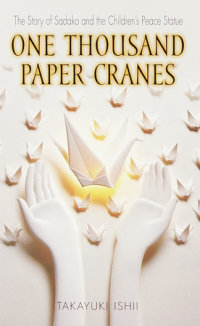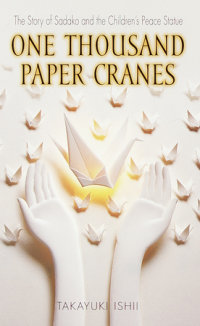One Thousand Paper Cranes
The inspirational story of the Japanese national campaign to build the Children's Peace Statue honoring Sadako and hundreds of other children who died as a result of the bombing of Hiroshima.
Ten years after the atomic bomb was dropped on Hiroshima, Sadako Sasaki died as a result of atomic bomb disease. Sadako's determination to fold one thousand paper cranes and her courageous struggle with her illness inspired her classmates. After her death, they started a national campaign to build the Children's Peace Statue to remember Sadako and the many other children who were victims of the Hiroshima bombing. On top of the statue is a girl holding a large crane in her outstretched arms. Today in Hiroshima Peace Memorial Park, this statue of Sadako is beautifully decorated with thousands of paper cranes given by people throughout the world.
An Excerpt fromOne Thousand Paper Cranes
Between 1941 and 1945, Japan was involved in the Second World War, a conflagration that engulfed most of the world. In 1945, the end of the war was drawing near, and Japan, Germany and Italy were facing defeat by the Allied Forces, including the United States and Great Britain. All of Japan’s major cities were under constant aerial bombardment. Large squadrons of heavy B-29 bombers repeatedly firebombed Tokyo, Yokohama, Osaka and Nagoya.
Most of these cities became seas of fire as a result of these bombings. Upon impact, a typical fire bomb spread an intensely hot, burning oil-like substance over large areas, destroying everything it touched. At the time most, most Japanese houses were constructed entirely of wood, so they were easily ignited and quickly burned to the ground. Many houses were intentionally destroyed to make empty spaces to slow down the spread of fire throughout Japan.
Meanwhile, scientists in the United States were creating a far more devastating bomb-the world’s first atomic bomb. The first atomic bomb was developed in Los Alamos, New Mexico, and passed its first test on July 16, 1945. The U.S Army had already targeted a Japanese city for the first bombing.
Hiroshima was the first choice, Kokura the second choice, and Nagasaki, the third. These cities were chosen because they were manufacturing centers of military equipment in the Japanese war effort. U.S. military leaders determined that a clear, cloudless day would be the most suitable for this mission.
The atomic bomb which was dropped in Hiroshima produced a very large amount of radiation. Sadako’s death, ten years after the Hiroshima bombing, was caused by radiation exposure.
Radiation can’t be seen, but it’s like light; it penetrates and permeates everything and everyone that is near it. Once exposed to radiation, even a small degree of it, living things will begin to deteriorate and will eventually die. In some cases, radiation sickness progresses in the human body slowly over a long period of time. Such was the case for Sadako.
Due to the severity of the radiation over Hiroshima and Nagasaki, it was believed by many scientists that no trees, grass, vegetation or human life would be able to live in these cities for a hundred years.


